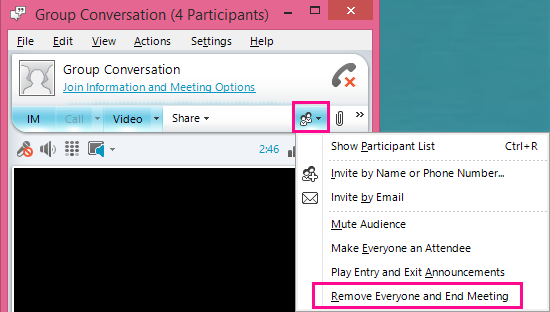
Use the Lync Online participant and content management options for a productive and distraction-free meeting.
Important: If you are not the meeting organizer or lead presenter, be aware that many of these options affect what others are able to see, hear, or do in the meeting. Presenter discretion is advised.
You can perform most meeting management tasks by right-clicking one or more people in the participant list, or by using the People Options menu

It’s best to keep the participant list in view during the meeting so you can track who is there, who is speaking, and who might be having trouble with audio or sharing. However, you may need to hide the participant list to, for example, review a long instant message (IM) conversation.
Important: You can mute and unmute participants who are using Lync for audio. You cannot mute or unmute participants who are connected to the meeting’s audio with a phone, that is, those who have used Lync’s Call me feature to have the Lync Meeting call a phone number or by dialing in. (People connected with a phone can press *1 on their phone key pad to access touch-tone commands for audio features, including mute and unmute.)
Tip: Choose this option when there are so many presenters that it is disrupting the flow of the meeting.
The meeting lobby only works for participants that connect to the meeting using VoIP. Participants that dial into the meeting using their phone will bypass the meeting lobby.
To invite others by using Lync Online, do the following.
To invite others by sending an email message, do the following:
In Lync Online, meeting content is displayed to the right of the participant list in an area called the stage. If you’re the active presenter, you work with Microsoft PowerPoint presentations, whiteboards, and meeting polls in this area. When you share a program or your desktop, everyone else in the meeting sees what you’re sharing on the stage as well.
Before the meeting starts, do the following:
For details, see the appropriate procedures later in this topic.
To upload a document so that participants can save a copy on their own computer, do the following:
You or anyone in the meeting can annotate a whiteboard or PowerPoint slide in the following ways:
For details about the annotation tools, see Collaborate on a whiteboard.
Note: Annotation tools are not available for shared content. If you are sharing your desktop or a program, others must request permission before making changes to the content you are sharing.
You can change who can do what with shared content.
By default, other presenters can view meeting content privately without affecting what others in the meeting see. Other presenters can page through the PowerPoint slides you’re showing at their own pace, or switch to another item in the Content List.
To change private viewing options for meeting content, do the following:
Note: Shared desktops or programs cannot be viewed privately.
By default, only presenters have extended access to meeting content. To change this, do the following:
When you choose Presenters or Everyone, people in that category can control PowerPoint presentations, whiteboards, and polls in the following ways:
By default, everyone in the meeting can save and view meeting attachments. To change this, do the following:
To add video to the meeting, do the following:
You can either end the meeting and disconnect everyone, or just close the window and let others continue with the meeting.
Exit and end the meeting

Important: We recommend you use the Remove Everyone and End Meeting option to avoid charges from your audio conferencing provider, in case people forget to disconnect their audio. The only exception is if you want to allow the participants to continue the Lync Meeting in your absence.